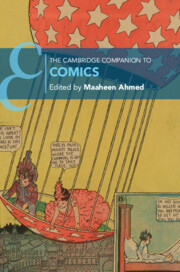Book contents
- The Cambridge Companion to Comics
- The Cambridge Companion to Comics
- Copyright page
- Contents
- Figures
- Contributors
- Acknowledgments
- Chronology
- Introduction
- Part I Forms
- Part II Readings
- Chapter 6 Comics and Multimodal Storytelling
- Chapter 7 Comics Adaptations
- Chapter 8 Comics Genres
- Chapter 9 Life Writing in Comics
- Chapter 10 Racialines
- Chapter 11 Women and Comics
- Chapter 12 Comics at the Limits of Narration
- Part III Uses
- Further Reading
- Index
- Cambridge Companions To …
- References
Chapter 10 - Racialines
Interrogating Stereotypes in Comics
from Part II - Readings
Published online by Cambridge University Press: 17 August 2023
- The Cambridge Companion to Comics
- The Cambridge Companion to Comics
- Copyright page
- Contents
- Figures
- Contributors
- Acknowledgments
- Chronology
- Introduction
- Part I Forms
- Part II Readings
- Chapter 6 Comics and Multimodal Storytelling
- Chapter 7 Comics Adaptations
- Chapter 8 Comics Genres
- Chapter 9 Life Writing in Comics
- Chapter 10 Racialines
- Chapter 11 Women and Comics
- Chapter 12 Comics at the Limits of Narration
- Part III Uses
- Further Reading
- Index
- Cambridge Companions To …
- References
Summary
This chapter assesses a pivotal moment in the formation of racial stereotypes in comics in the 1890s and 1900s, when racialized caricature became a foundational element of newspaper comics in the United States. Combining theoretical reflections on stereotypes and on the stereotypical structures of comics, the chapter offers exemplary analyses of E.W. Kemble’s, Richard F. Outcault’s, Rudolph Dirks’s, and Winsor McCay’s ongoing investments in what I call racialines: the broadly entertaining and increasingly popular confluence of the drawn line and the blackened spaces it encapsulates in the graphic rendition of stereotypical “blackness.” The chapter argues that these often conflicted investments in racist visual culture at the turn of the twentieth century facilitated the emergence of new visions of “blackness,” giving rise to a print world of stereotypical depiction where comics offered a playing field for the racialized visual imagination and taught Americans to indulge in images and narratives of “race” in ways that habitually solidified yet also, at times, irritated more conventional notions of normative “whiteness.”
- Type
- Chapter
- Information
- The Cambridge Companion to Comics , pp. 204 - 224Publisher: Cambridge University PressPrint publication year: 2023



